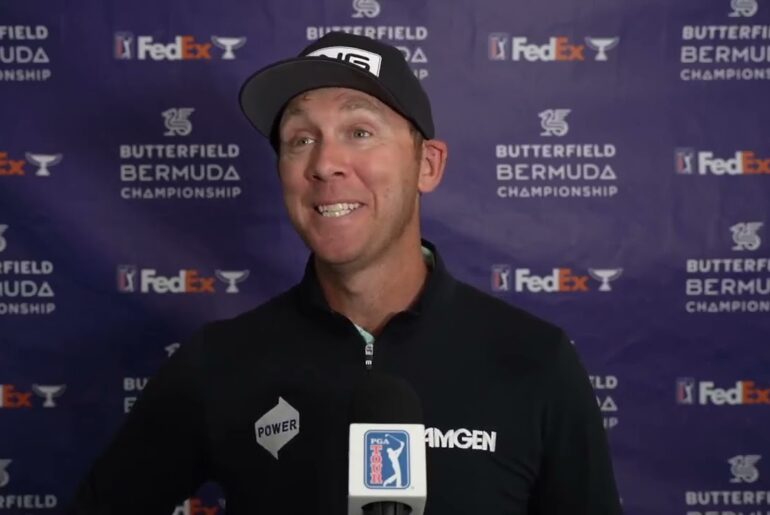Former professional golfer Hudson Swafford shares his story of transitioning from the golf course to a new career in real estate. After being released from LIV Golf and facing a lengthy suspension from the PGA Tour, Swafford made a bold move to pursue a different path. Learn about his experiences, the challenges he faced, and how he’s embracing life off the green.
Discover why Swafford decided to take a break from golf, his thoughts on the PGA Tour’s suspension rules, and how he’s enjoying more family time while working in the real estate industry. Get an inside look at the life of a golfer turned real estate agent, and find out what the future holds for Hudson Swafford’s golf career.
Imagine being at the peak of your golfing career only to find yourself ousted from one tour and banned from another. That’s precisely the situation Hudson Swafford, a former LIV golf player, faced. But here’s the twist. He’s traded his clubs for keys and is now navigating the world of real estate. Published on October 26th, 2025, this story details Swafford’s unexpected career shift following a tumultuous period in his professional golfing life. After LIIV Golf decided not to renew his contract last year, Swafford, now 38, found himself at a crossroads. He’d been an LIV wild card, meaning he wasn’t guaranteed a spot, but was given a chance to compete. However, his performance didn’t meet expectations after an initial T36 finish leading to his release. This left him ineligible to rejoin the PGA Tour, a consequence of his earlier decision to join LIIV back in 2022. Swafford was among the first wave of players to make the jump from the PGA Tour to the Venent LIV Golf. This decision, while lucrative in the short term, came with repercussions. The three-time PGA title winner participated in five LIIV events that year, resulting in a lengthy ban from the PGA Tour. Think of it as a professional divorce. Severing ties with the PGA Tour had long-term consequences. His 2023 season was further hampered by a hip injury. And while the wildcard spot offered a chance at redemption, his performance didn’t secure his future in the sport, especially considering the PGA ben looming over him. And this is the part most people miss. The ban wasn’t just a slap on the wrist. It was a multi-year suspension. Facing an uncertain future in golf, Swafford made a bold choice. Instead of seeking refuge on another golf tour, he decided to step away from the sport entirely and explore a different career path. This decision speaks volumes about the pressures and demands of professional golf and how some athletes prioritize other aspects of their lives. Now, Swafford is working for a real estate company in Atlanta, Georgia. While he hasn’t completely closed the door on a potential return to golf, he admits he’s enjoying his new career and the increased time he gets to spend with his family. He shared his thoughts on the subpar podcast, explaining that his golf game had been suffering, especially on LIIV. I had been struggling with my golf as my scores reflected, especially on LIIV the last few years. I’ve been in a pretty bad place with golf, Swafford said, emphasizing the relief and refreshment he’s found in pursuing something new. It’s a testament to the idea that sometimes the best move is a change of scenery. He also highlighted the impact of professional golf on family life. I mean, golf is amazing. competing at the highest level is the best. But it’s very tough on a family life and I have three kids. So seeing that aspect and being around a lot more has really been kind of eye opening and it’s actually been really really enjoyable. Despite discussions with the PGA Tour, Swafford’s ban is currently slated to end in 2027. But here’s where it gets controversial. Swaffford claims that PGA is basing the length of his suspension on the number of LIIV events he played in 2022, effectively handing out a one-year suspension for each event. He explained, “I’ve had some good back and forths with the PGA Tour, but then some wishy-washy,” and added, “It’s still not set in stone. I know they’ve set up suspended until 27, which I know they’re basing that on a couple of people’s contracts being up after the 26th season, so then they can kind of change rules in favor of everybody coming back. He doesn’t seem entirely convinced by the justification for the length of his ban. I don’t know how you can come up with a five or five and a half year suspension based on I played five events while the PGA Tour season was going on in 22 that I wasn’t able to get media releases for, he said, suggesting he feels the penalty is disproportionate. Looking ahead, Swafford acknowledges that the PGA tour landscape might be drastically different by the time his ban is lifted. He anticipates changes to qualifying rules and event formats, potentially impacting his ability to compete should he choose to return. Problem is, if I come in and talk to them, it’s like, okay, I can come back and play in 27, but what does 27 on the PGA Tour really look like? He questioned. He also predicts the phasing out of the past champions category, which could further limit his opportunities. So, I mean, I guess you can sign up for Monday qualifiers, but really, I’d be basically suspended until Q school of 27. Swafford’s story highlights the complex and evolving relationship between the PGA Tour and LIV Golf and the personal sacrifices players make when navigating these competing interests. It also serves as a reminder that careers aren’t always linear, and sometimes the greatest opportunities arise from unexpected days. Considering the potential for reconciliation between the PGA and LIIV and the evolving landscape of professional golf, do you think Swafford’s ban is justified? Should players who initially jumped to LIIV be subject to such lengthy suspensions, or should the PGA Tour offer a more lenient path back? What are your thoughts?








1 Comment
Sad, he still a hell of a player!